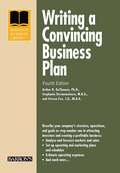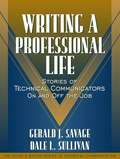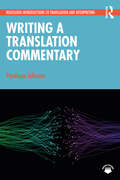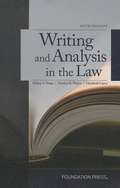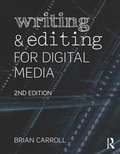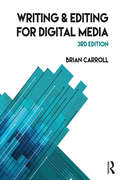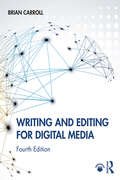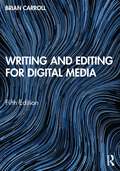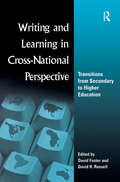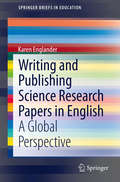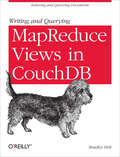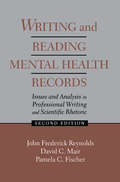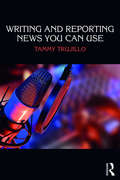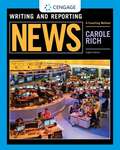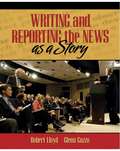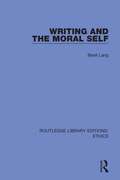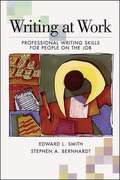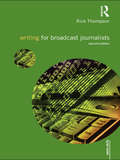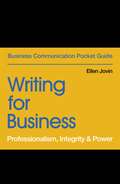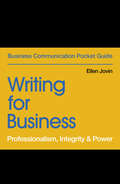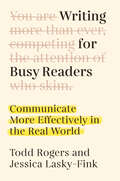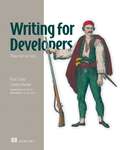- Table View
- List View
Writing a Convincing Business Plan (Barron's Business Library)
by Steven Fox Arthur DeThomas Stephanie DerammelaereA sound and convincing business plan is an entrepreneur’s important first step in starting up a profitable business. It’s also a prerequisite for getting financing and attracting investors. A sound business plan describes the business operations and goals, analyzes and forecasts markets and sales, sets up operating and marketing plans and schedules, and estimates operating expenses. This book shows how to organize and write a logical, business-savvy, and professionally polished business plan that can be presented to potential investors and financial institutions.
Writing a Professional Life: Stories of Technical Communicators On and Off the Job
by Gerald J. Savage Dale L. SullivanThis is the first collection of narratives by practicing technical communicators telling their own personal stories about the workplace and their lives on the job. The authors portray a wide range of jobs: writers, editors, interface designers, marketing writers, and trainers working in 9 different technical fields, including software, R&D, engineering , medicine, transportation, and telecommunications. The stories vividly demonstrate the unique power of narrative as a teaching and learning tool. Unlike fabricated cases, these real-life narratives show new and veteran technical writers at work on the job, dealing with tasks, clients, and co-workers, and revealing their insights, values, and attitudes about their work. The stories also show the skills required in the profession and the ethical and other issues raised in the course of the workday. For anyone interested in technical communication and professional writing.
Writing a Translation Commentary (Routledge Introductions to Translation and Interpreting)
by Penélope JohnsonThis essential textbook is a step-by-step guide to how to write a self-reflective translation commentary, a key requirement of most courses on translation. Starting with source text analysis, it guides students in how to set out a translation strategy and goes through the most common challenging issues encountered, thus enabling students to set out their translation priorities in an informed manner. Throughout each chapter, there are boxes summarising key concepts and suggestions of tasks and activities, as well as recommendations for further reading. The book is supplemented by online resources for students and teachers on the translation studies portal. There are nine PowerPoints based on the chapters of the book that could be used for teaching or self-study. There are also downloadable versions of sample assessment rubrics, tables for example selection, and checklists. Based on real life examples of students' work in different language combinations, drawing on the author's years of experience of teaching commentary writing, this book focuses on several types of language mediation that go beyond the written word, such as interpreting, audiovisual translation, localisation, and transcreation. This is a vital textbook for students writing commentaries on translation and interpreting courses, a useful resource for supervisors providing students with guidance on how to write a balanced, articulate, and convincing commentary and a handy reference for professional translators and interpreters needing to explain their translation decisions to clients.
Writing about Archaeology
by Graham ConnahIn this book, Graham Connah offers an overview of archaeological authorship: its diversity, its challenges, and its methodology. Based on his own experiences, he presents his personal views about the task of writing about archaeology. The book is not intended to be a technical manual. Instead, Connah aims to encourage archaeologists who write about their subject to think about the process of writing. He writes with the beginning author in mind, but the book will be of interest to all archaeologists who plan to publish their work. Connah's overall premise is that those who write about archaeology need to be less concerned with content and more concerned with how they present it. It is not enough to be a good archaeologist. One must also become a good writer and be able to communicate effectively. Archaeology, he argues, is above all a literary discipline.
Writing and Analysis in the Law, Sixth Edition
by Helene S. Shapo Marilyn R. Walter Elizabeth FajansA standard-setter in American legal education, Writing and Analysis in the Law provides a guide to legal writing, focusing on the importance of clear organization in written communications. Developed as a textbook for a first-year law school course, and is successful in courses for foreign LLM students, the book introduces law students to analyzing and writing about legal authority in cases and statutes. It discusses the structure and persuasive techniques of effective argumentation. The book makes effective use of high-quality and illustrative examples and writing exercises. It also includes access to helpful PowerPoint slides for use in the classroom and class preparation. Lucid, compact, and up-to-date, this work consistently draws acclaim in law schools across the country. <P><P>The sixth edition has been streamlined and designed to be reader friendly: it uses white space, bullet points, tabulation, and headings that chunk information to enable student to grasp information efficiently.
Writing and Editing for Digital Media
by Brian CarrollWriting and Editing for Digital Media, 2nd edition, teaches students how to write effectively for digital spaces--whether crafting a story for a website, blogging or using Twitter to cover a breaking news story or event. The lessons and exercises in each chapter help students build a solid understanding of the ways that digital communications have introduced opportunities for dynamic storytelling and multi-directional communication. Writing and Editing for Digital Media also addresses the graphical, multimedia, hypertextual and interactive elements that come into play when writing for digital platforms and designing digital spaces. The book teaches students not only to create content, but also to become careful, creative managers of that content. Based on Brian Carroll's extensive experience teaching the course, this revised and updated edition pays particular attention to opportunities presented by the growth of social media and mobile media. Chapters aim to: Assist digital communicators in understanding the social networked, increasingly mobile, always-on, geomapped, personalized media ecosystem; Help writers across multiple communication fields (journalism, marketing, PR, technical writing) make the transition from print to digital; Teach communicators to approach storytelling from a multimedia, multi-modal, interactive perspective. A companion website with exercises and assignments gives students the tools they need to put theory into practice.
Writing and Editing for Digital Media
by Brian CarrollWriting and Editing for Digital Media teaches students how to write effectively for digital spaces—whether writing for an app, crafting a story for a website, blogging, or using social media to expand the conversation. The lessons and exercises in each chapter help students build a solid understanding of the ways that digital communication has introduced opportunities for dynamic storytelling and multi-directional communication. With this accessible guide and accompanying website, students learn not only to create content, but also to become careful, creative managers of that content. Updated with contemporary examples and pedagogy, including examples from the 2016 presidential election, and an expanded look at using social media, the third edition broadens its scope, helping digital writers and editors in all fields, including public relations, marketing, and social media management. Based on Brian Carroll's extensive experience teaching a course of the same name, this revised and updated edition pays particular attention to opportunities presented by the growth of social media and mobile media. Chapters aim to: Assist digital communicators in understanding the socially networked, increasingly mobile, always-on, geomapped, personalized media ecosystems; Teach communicators to approach storytelling from a multimedia, multi-modal, interactive perspective; Provide the basic skill sets of the digital writer and editor, skill sets that transfer across all media and most communication and media industries, and to do so in specifically journalistic and public relations contexts; Help communicators to put their audiences first by focusing attention on user experience, user behavior, and engagement with their user bases; Teach best practices in the areas of social media strategy, management, and use.
Writing and Editing for Digital Media
by Brian CarrollIn this new edition, Brian Carroll explores writing and editing for digital media with information about voice, style, media formats, and content development, combining hands-on exercises with new sections on idea generation, multi-modal storytelling, podcasting, and information credibility. Carroll explains and demonstrates how to effectively write for digital spaces – whether crafting a story for a website, writing for an app, blogging, or using social media to expand the conversation. Each chapter features lessons and exercises through which students can build a solid understanding of the ways that digital communication provides opportunities for dynamic storytelling and multi-directional communication. Updated with contemporary examples and new pedagogy, the fourth edition broadens its scope, helping digital writers and editors in all fields, including public relations, marketing, and social media management. Writing and Editing for Digital Media is an ideal handbook for students from all backgrounds who are looking to develop their writing and editing skills for this ever-evolving industry.
Writing and Editing for Digital Media
by Brian CarrollIn this fifth edition, Brian Carroll explores writing and editing for digital media with essential information about voice, style, media formats, ideation, story planning, and storytelling. Carroll explains and demonstrates how to effectively write for digital spaces and combines hands-on, practical exercises with new material on podcasting, multi-modal storytelling, misinformation and disinformation, and writing specifically for social media. Each chapter features lessons and exercises through which students can build a solid understanding of the ways that digital communication provides opportunities for dynamic storytelling and multi-directional communication. Broadened in scope, this new edition also speaks to writers, editors, public relations practitioners, social media managers, marketers, as well as to students aspiring to these roles. Updated with contemporary examples and new pedagogy throughout, this is the ideal handbook for students seeking careers in digital media, particularly in content development and digital storytelling. It is an essential text for students of media, communication, public relations, marketing, and journalism who are looking to develop their writing and editing skills for these ever-evolving fields and professions. This book also has an accompanying eResource that provides additional weekly activities, exercises, and assignments that give students more opportunity to put theory into practice.
Writing and Learning in Cross-national Perspective: Transitions From Secondary To Higher Education
by David Foster David R. RussellDespite the increasingly global implications of conversations about writing and learning, U.S. composition studies has devoted little attention to cross-national perspectives on student writing and its roles in wider cultural contexts. Caught up in our own concerns about how U.S. students make the transition as writers from secondary school to postsecondary education, we often overlook the fact that students around the world are undergoing the same evolution. How do the students in China, England, France, Germany, Kenya, or South Africa--the educational systems represented in this collection--write their way into the communities of their chosen disciplines? How, for instance, do students whose mother tongue is not the language of instruction cope with the demands of academic and discipline-specific writing? And in what ways is U.S. students' development as academic writers similar to or different from that of students in other countries? With this collection, editors David Foster and David R. Russell broaden the discussion about the role of writing in various educational systems and cultures. Students' development as academic writers raises issues of student authorship and agency, as well as larger issues of educational access, institutional power relations, system goals, and students' roles in society. The contributors to this collection discuss selected writing purposes and forms characteristic of a specific national education system, describe students' agency as writers, and identify contextual factors--social, economic, linguistic, cultural--that shape institutional responses to writing development. In discussions that bookend these studies of different educational structures, the editors compare U.S. postsecondary writing practices and pedagogies with those in other national systems, and suggest new perspectives for cross-national study of learning/writing issues important to all educational systems. Given the worldwide increase in students entering higher education and the endless need for effective writing across disciplines and nations, the insights offered here and the call for further studies are especially welcome and timely.
Writing and Publishing Science Research Papers in English
by Karen EnglanderThis book provides a comprehensive review of the current knowledge on writing and publishing scientific research papers and the social contexts. It deals with both English and non-Anglophone science writers, and presents a global perspective and an international focus. The book collects and synthesizes research from a range of disciplines, including applied linguistics, the sociology of science, sociolinguistics, bibliometrics, composition studies, and science education. This multidisciplinary approach helps the reader gain a solid understanding of the subject. Divided into three parts, the book considers the context of scientific papers, the text itself, and the people involved. It explains how the typical sections of scientific papers are structured. Standard English scientific writing style is also compared with science papers written in other languages. The book discusses the strengths and challenges faced by people with different degrees of science writing expertise and the role of journal editors and reviewers.
Writing and Querying MapReduce Views in CouchDB: Tools for Data Analysts
by Bradley HoltIf you want to use CouchDB to support real-world applications, you'll need to create MapReduce views that let you query this document-oriented database for meaningful data. With this short and concise ebook, you'll learn how to create a variety of MapReduce views to help you query and aggregate data in CouchDB’s large, distributed datasets.You'll get step-by-step instructions and lots of sample code to create and explore several MapReduce views through the course of the book, using an example database you construct. To work with these different views, you’ll learn how to use the Futon web administration console and the cURL command line tool that come with CouchDB.Learn how the Map and Reduce steps work independently and together to index your dataUse the example database to create several temporary views based on different criteriaDiscover the uses of Map and Reduce JavaScript functionsConvert your temporary views to permanent views within a design documentLearn several options for querying the data within your viewsLimit the number of results returned, skip some results, or reverse the order of the outputGroup your results by exact keys or by parts of keysBradley Holt, co-founder of the creative services firm Found Line, is a web developer and entrepreneur ten years of PHP and MySQL experience. He began using CouchDB before the release of version 1.0. Bradley is an active member of the PHP community, and can be reached at bradley-holt.com.
Writing and Reading Mental Health Records: Issues and Analysis in Professional Writing and Scientific Rhetoric
by J. Frederick Reynolds David C. Mair Pamela C. FischerThis revised and updated second edition is a rhetorical analysis of written communication in the mental health community. As such, it contributes to the growing body of research being done in rhetoric and composition studies on the nature of writing and reading in highly specialized professional discourse communities. Many compelling questions answered in this volume include: * What "ideological biases" are reflected in the language the nurse/rhetorician uses to talk to and talk about the patient? * How does language figure into the process of constructing meaning in this context? * What social interactions -- with the patient, with other nurses, with physicians -- influence the nurse's attempt to construct meaning in this context? * How do the readers of assessment construct their own meanings of the assessment? Based on an ongoing collaboration between composition studies specialists and mental health practitioners, this book presents research of value not only to writing scholars and teachers, but also to professional clinicians, their teachers, and those who read mental health records in order to make critically important decisions. It can also be valuable as a model for other scholars to follow when conducting similar long-range studies of other writing-intensive professions.
Writing and Reporting News You Can Use: News You Can Use
by Tammy TrujilloWriting and Reporting News You Can Use instructs students on how to produce news that is informative, interesting, educational, and most importantly, compelling. It addresses roadblocks to student interest in writing news, using illustrative examples and exercises to help them understand how to write news that is interesting and accurate. Trujillo’s hands-on approach is based on real-world strategies that deal with audience and market characteristics. Students are writing from the very beginning while also getting the ethical and legal grounding necessary to understand the field. This textbook is a complete resource for students learning broadcast news, including how to get a job after leaving the classroom.
Writing and Reporting News: A Coaching Method
by Carole RichPulling examples straight from recent headlines, WRITING AND REPORTING NEWS: A COACHING METHOD, 8e uses tips and techniques from revered writing coaches and award-winning journalists to help you develop the writing and reporting skills you need to succeed in the changing world of journalism. Full-color photographs and a strong storytelling approach keep you captivated throughout the book. <P><P>An entire chapter is devoted to media ethics, while ethical dilemmas in each chapter give you practice working through ethical issues before you face them on the job. Offering the most up-to-date coverage available, the Eighth Edition fully integrates multimedia content into the chapters-reflecting the way the news world actually operates. It also includes an all-new book glossary featuring many of the newer terms used in Journalism. Integrating new trends in the convergence of print, broadcast, and online media, WRITING AND REPORTING NEWS equips you with the fundamental skills you need for media careers now-and in the future.
Writing and Reporting for the Media, Eleventh Edition
by John R. Bender Lucinda D. Davenport Michael W. Drager Fred FedlerA fundamental introduction to news writing and reporting, this classic text focuses on the basics of reporting, including critical thinking, thorough reporting, excellent writing and creative visual communication skills for stories across all media, and continues to be a top resource for journalism courses.
Writing and Reporting the News as a Story
by Robert Lloyd Glenn GuzzoFilled with current examples and tips from Pulitzer-Prize winning professionals, Writing and Reporting News as a Story teaches modern news writing skills while providing timely advice on ethics and career advancement. As a result of the outstanding professional experience of the author team and their devotion to teaching, this new text offers practical and real guidance to readers truly interested in a future in journalism.
Writing and Society
by Florian CoulmasHow does writing relate to speech? What impact does it have on social organisation and development? How do unwritten languages differ from those that have a written form and tradition? This book is a general account of the place of writing in society. Drawing on contemporary and historical examples, from clay tablets to touchscreen displays, the book explores the functions of writing and written language, analysing its consequences for language, society, economy and politics. It examines the social causes of illiteracy, demonstrating that institutions of central importance to modern society are built upon writing and written texts, and are characterised by specific forms of communication. It explores the social dimensions of spelling and writing reform, as well as of digital literacy, a new mode of expression and communication posing novel challenges to the student of language in society.
Writing and the Moral Self
by Berel LangOriginally published in 1991, this book analyses the relation between writing and ethics in a number of social contexts – in politics, as language discloses its connections to the institutions of totalitarianism and democracy; in the university, as contemporary scholarly ideals find an uncomfortably accurate representation in the stylistic forms of academic writing; in daily social practice, ranging from the status of truth in journalistic writing to the connection between pronouns and affirmative action; and finally in the ethical structure of language itself.
Writing at Work: Professional Writing Skills for People on the Job
by Edward L. Smith Stephen A. BernhardtWriting at Work's for people who do or will write while on the job whether the writing be an interoffice memo, e-mail, a status report, a lab report, marketing materials, or a letter to a customer. The philosophy behind Writing at Work's that such writing needn't be stale and unoriginal but can instead be a sophisticated piece of work that positively reflects the competence of its composer to all who read it. Rather than dwell on picky, little "rules" that you must adhere to when writing, Writing at Work focuses on the real rules of grammar and aspects of style that you really need to know in order to write with confidence. Using examples realistically drawn from work settings, Writing at Work presents each topic in a manner that is at once accessible and inviting. Spread throughout the text are exercises that provide you with ample opportunity to write, revise, and correct the kinds of written tasks typically encountered at work. You can immediately gauge your progress by checking your work against the answers listed at the end of each chapter.
Writing for Broadcast Journalists (Media Skills)
by Rick Thompson'This is a superb book which combines the rare mixture of high quality information with humour. The style of writing engages the reader from the introduction and the experience and insight of the author occasionally makes it difficult to put down, a rare feature of a textbook. I would unreservedly recommend this book not only to those studying journalism but to students of language and all who use the spoken and written word as the ‘materials’ of their work.' Barry Turner, Nottingham Trent University 'Rick Thompson's guidance manual is packed with advice to would-be writers for this medium. He's someone with years of experience at the top level of the national and international profession, and he's smack up to date with his references. The book is aimed at journalists, but anyone with a serious interest in developing their literacy will learn a lot about professional writing skills from what he has to say.' Roy Johnson, www.mantex.co.uk Writing for Broadcast Journalists guides readers through the significant differences between the written and the spoken versions of journalistic English. It will help broadcast journalists at every stage of their careers to avoid such pitfalls as the use of newspaper-English, common linguistic errors, and Americanised phrases, and gives practical advice on accurate terminology and pronunciation, while encouraging writers to capture the immediacy of the spoken word in their scripts. Writing for Broadcast Journalists includes: practical tips on how to avoid ‘journalese’, clichés and jargon guidance on tailoring your writing style to suit a particular audience advice on converting agency copy into spoken English writing to television pictures examples of scripts from some of the best in the business an appendix of ‘dangerous’ words and phrases to be avoided in scripts.
Writing for Business: Professionalism, Integrity & Power
by Ellen JovinBuild essential skills and write with confidence at work! Immediately practical guide to better business writing designed to help you develop a clear, direct, natural communication style that supports rather than obscures what you want to say. Writing for Business covers writing principles that are relevant for a wide range of business documents, including email, letters, memos, reports, proposals, and more, while also offering editing tips to ensure you come across as professional and polished. The book features examples and tips straight from the workplace.
Writing for Business: Professionalism, Integrity & Power (Business Communication Pocket Guides)
by Ellen JovinBuild essential skills and write with confidence at work! Immediately practical guide to better business writing designed to help you develop a clear, direct, natural communication style that supports rather than obscures what you want to say. It covers writing principles relevant for a wide range of business documents, including email, letters, memos, reports, proposals, and more, while also offering editing tips to ensure you come across as professional and polished. Packed with examples and tips straight from the workplace.
Writing for Busy Readers: Communicate More Effectively in the Real World
by Todd Rogers Jessica Lasky-FinkWriting well is for school. Writing effectively is for life. Todd Rogers and Jessica Lasky-Fink offer the most valuable practical writing advice today. Building on their own research in behavioral science, they outline cognitive facts about how people actually read and distill them into six principles that will transform the power of your writing: Less is moreMake reading easyDesign for easy navigationUse enough formatting, but no moreTell readers why they should careMake responding easyIncluding many real-world examples, a checklist and other tools, this guide will make you a more successful and productive communicator. Rogers and Lasky-Fink bring Strunk and White&’s core ideas into the twenty-first century&’s attention marketplace. When the influential guides to writing prose were written, the internet hadn&’t been invented. Now, the average American adult is inundated with digital messages each day. With all this correspondence, capturing a busy reader&’s attention is more challenging than ever. This is how to do it.
Writing for Developers: Blogs that get read
by Piotr Sarna Cynthia DunlopPragmatic methods for writing blogs, articles, and other technical pieces that stand out from the crowd!Do you want to connect with your community, share your state-of-the-art achievements, and help your peers benefit from your hard-fought lessons learned? Do you want to get the kind of attention that expands your career? Master the art of writing engineering blog posts and articles! This comprehensive guide shows you how to create content your fellow developers will love to read and share. Writing for Developers is full of the practical tips, tricks, and techniques you need to translate the ideas floating around your head into content that&’s clear and compelling, including how to: • Pinpoint topics that make intriguing posts • Apply popular blog post design patterns • Rapidly plan, draft, and optimize blog posts • Make your content clearer and more convincing to technical readers • Tap AI for revision while avoiding misuses and abuses • Increase the impact of all your technical communications Whether you&’re brand new to writing, or a seasoned hand who wants more attention for your work, Writing for Developers will help ensure your writing resonates with readers. This isn&’t a generic writing guide—from start to finish, the book is laser-focused on technical topics, writers, and audiences. Authors Piotr Sarna and Cynthia Dunlop combine their differing perspectives as an engineer and professional writer to help you write compelling works. You&’ll learn through detailed examples, methodical strategies, and a &“punk rock DIY attitude!&” Foreword by Bryan Cantrill. Afterword by Scott Hanselman. About the technology A well-crafted technical article can spark a new idea, demystify a technology, expand your perspective, or save you from going down a disastrous path. Even if you don&’t consider yourself a &“good writer,&” you can make a difference by sharing insights and advancing the community. This practical guide shows you how to create blogs, articles, and other content your fellow developers will want to read and share. About the book Writing for Developers introduces seven popular patterns for modern engineering blogs—such as &“The Bug Hunt,&” &“We Rewrote It in X,&” and &“How We Built It&”—and helps you match these patterns with your ideas. This book covers the entire writing process, from brainstorming, planning, and revising, to promoting your blog in ways that build reputation and generate further opportunities. What's inside • Rapidly plan, draft, and review your content • Build on popular blog post design patterns • Support your writing with AI • Increase the impact of all your communications About the reader For developers and engineers of all ability levels—even if you&’re not a native English speaker and never took a writing class in your life. About the author Piotr Sarna is a software engineer and an experienced book and blog author. Cynthia Dunlop has been writing for and with developers for 20+ years.
